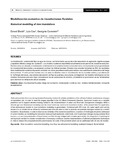Mostrar o rexistro simple do ítem
Modelización numérica de inundaciones fluviales
| dc.contributor.author | Bladé, Ernest | |
| dc.contributor.author | Cea, Luis | |
| dc.contributor.author | Corestein, Georgina | |
| dc.contributor.other | Enxeñaría da Auga e do Medio Ambiente (GEAMA) | es_ES |
| dc.date.accessioned | 2024-02-15T16:38:32Z | |
| dc.date.available | 2024-02-15T16:38:32Z | |
| dc.date.issued | 2014 | |
| dc.identifier.citation | Bladé Castellet, E., Cea, L., & Corestein, G. (2014). Modelización numérica de inundaciones fluviales. Ingeniería del agua, 18(1), 71-82. https://doi.org/10.4995/ia.2014.3144 | es_ES |
| dc.identifier.uri | http://hdl.handle.net/2183/35629 | |
| dc.description.abstract | [Resumen:] La modelización numérica del flujo de agua en ríos es una herramienta que ayuda a dar respuesta a la legislación vigente europea y española referida a riesgo de inundación. Los modelos numéricos disponibles actualmente se encuentran en constante evolución. Mientras hace una década la modelización unidimensional era prácticamente la única alternativa, en el presente se han generalizado los modelos bidimensionales y se empiezan a utilizar los tridimensionales. Gracias a las actuales herramientas SIG, los resultados de la modelización numérica se pueden combinar con datos georreferenciados para realizar una cuantificación sistemática del riesgo de inundación. En este proceso existen aún una serie de desafíos como la consideración de los caudales sólidos y sus efectos en la morfología del cauce, una correcta descripción del flujo en puentes y estructuras, la integración de modelos hidrológicos con los modelos hidráulicos para una mejor consideración de las condiciones de contorno, y finalmente la optimización de las herramientas para disminuir los tiempos de cálculo actuales. | es_ES |
| dc.description.abstract | [Abstract:] At the present time there is a strong demand from policy makers for reliable predictions of the effects of climate and land use changes on inundation risk, in order to meet the targets specified in the EU Water Framework Directive. Numerical models are a valuable predictive tool to support decision-making related to the implementation of water and flood risk management strategies. While a decade ago one-dimensional modelling was the most commonly used tool in inundation studies, at the present time the application of two-dimensional models to river inundation modelling is generalized. Combined with GIS tools, the water depth and velocity results of a 2D model can be efficiently combined with land use data in order to quantify the potential damages caused by a certain inundation. Nevertheless, in order to improve the reliability of the numerical predictions, a number of challenges should be addressed in current models, as: modelling the interaction between hydrodynamics, solid loads, and morphologic changes during extreme flood events; a correct characterisation of head losses and flow through bridges with complex geometries; the integration of hydrological and hydraulic models for a better consideration of boundary conditions; and the implementation of efficient parallelization techniques in order to reduce the computational time and increase the scale of the problems which can be addressed with 2D and 3D models. | es_ES |
| dc.language.iso | spa | es_ES |
| dc.publisher | Universitat Politècnica de València | es_ES |
| dc.relation.uri | https://doi.org/10.4995/ia.2014.3144 | es_ES |
| dc.rights | Atribución-NoComercial-CompartirIgual 3.0 España | es_ES |
| dc.rights.uri | http://creativecommons.org/licenses/by-nc-sa/3.0/es/ | * |
| dc.subject | Inundaciones fluviales | es_ES |
| dc.subject | Riesgo de inundación | es_ES |
| dc.subject | Modelización numérica | es_ES |
| dc.subject | Ríos | es_ES |
| dc.subject | Modelos bidimensionales | es_ES |
| dc.subject | Transporte de sedimentos | es_ES |
| dc.subject | River inundation | es_ES |
| dc.subject | Numerical modelling | es_ES |
| dc.subject | River flow | es_ES |
| dc.subject | Two-dimensional modelling | es_ES |
| dc.subject | Sediment transport | es_ES |
| dc.subject | Fluvial habitat | es_ES |
| dc.title | Modelización numérica de inundaciones fluviales | es_ES |
| dc.type | info:eu-repo/semantics/article | es_ES |
| dc.rights.access | info:eu-repo/semantics/openAccess | es_ES |
| UDC.journalTitle | Ingeniería del agua | es_ES |
| UDC.volume | 18 | es_ES |
| UDC.startPage | 71 | es_ES |
| UDC.endPage | 82 | es_ES |
| dc.identifier.doi | 10.4995/ia.2014.3144 |






